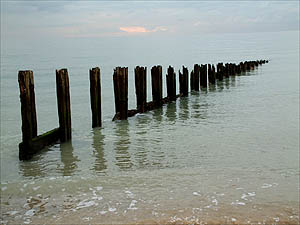Resilience and resistance

|
Coastal and marine ecosystems are constantly changing and can respond to environmental disturbances both slowly or quickly. Resistance is the capacity of an ecosystem to remain relatively unchanged when confronted by a disturbance, while resilience has been defined in different ways: it can be a measure for the speed at which an ecosystem returns to its former state following a disturbance. It is also used in a way that more closely resembles the definition of
Contents
Introduction
Coastal systems are naturally resilient. ... This article will discuss. In particular it will argue that ...Biodiversity allows ecosystems to adapt to changing conditions. Humans, however, have acted to increase the rate of change and consequently, it will be a great challenge for the marine environment to adapt rapidly enough in the future. These changes have been induced through pollution, fishing, sediment deposition and alteration of the global climate. Without genetic diversity, natural selection cannot occur and natural selection is limited, then adaptation is impossible. It is evident that the preservation of biodiversity and, more specifically, genetic diversity is of paramount importance for successful adaptation to our rapidly changing environments.
Resilience through re-colonization
Resistance to changes in abiotic and biotic factors
Community composition and ecosystem function may change very little under environmental change when the organisms can acclimate to such change or tolerate it for some time (when the change is only temporary). However, all organisms have bounds to what they can temporarily or permanently tolerate, and when change exceeds some of these limits, the community compostion and ecosystem functioning is likely to change.
It is unlikely that communities can be resistant to continuous gradual change, such as global warming. Acclimation and phenotypic plasticity do not suffice to maintain the system as it is. Genetic adaptation could allow community members to track such abiotic environmental change, but it is more likely that the area where the community is functioning will be invaded by species that function well at higher temperatures. The original species will thus have to deal with new competitors and predators, in addition to the changed abiotic factor. To some extent the original community can track the preferred temperature range, by moving spatially to greater depths or to alternative gepgraphic areas. But these new areas are likely to differe in other ecological aspects such as water pressure, light climate and perhaps speeds of water flow etc.
Adaptation and the consequences of mortality at different trophic levels
Assisting Adaptation
Protecting sources, not sinks when creating Marine Protected Areas. Protecting sources of populations at all stages of succession, to preserve 'ecological memory' to the fullest possible extent. This includes protecting not only 'high quality' habitats that harbour healthy mature communities, but also 'low quality' and disturbed habitats that are required for those species that contribute to early recovery of perturbed areas (see Rossi et al. 2009).
References
Abrams, P.A & Vos, M. 2003. Adaptation, density dependence and the responses of trophic level abundances to mortality. Evolutionary Ecology Research 5:1113-1132.
DeAngelis, D. L. 1992. Dynamics of Nutrient Cycling and Food Webs. Chapman and Hall, London.
Rossi, F., Vos, M. & Middelburg, J.J. 2009. Species identity, diversity and microbial carbon flow in reassembling macrobenthic communities. Oikos, Early View, (January issue).
See Also
Resilience as a criterion in marine biological evaluation
Please note that others may also have edited the contents of this article.
|
